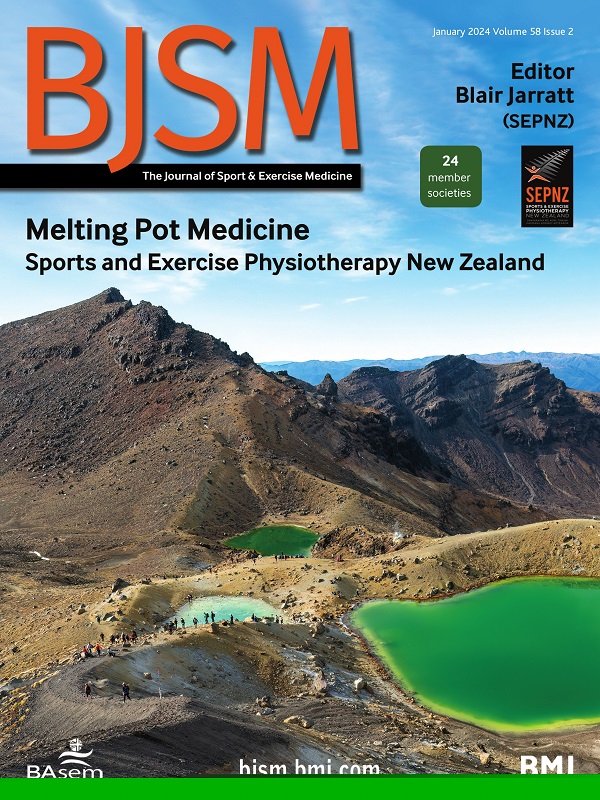Call to integrate long tail and dark data for the advancement of sports medicine research
IF 16.2
1区 医学
Q1 SPORT SCIENCES
引用次数: 0
Abstract
The proliferation of observational and interventional research in the fields of sports medicine and orthopaedics has resulted in a rapid expansion of available knowledge. However, as the volume of evidence has increased, so has the number of independent investigators leading to the collection and storage of small, granular datasets by individual labs during routine research.1 There are growing concerns within sports medicine and related fields that the complex nature of the current scientific environment may limit the efficiency of data aggregation and that variation in the structure of individual datasets may limit the application of rigorous quantitative methods when answering challenging clinical or practical questions.2 3 Therefore, this editorial aims to introduce the concepts of long tail data and dark data in sports medicine research and describe the implications of both data types for advancing the field. The concepts of long tail data and dark data are becoming increasingly relevant in sports medicine and orthopaedics research. Long tail data refers to the vast amount of small, specialised datasets that exist outside of mainstream, large-scale studies.2 4 These datasets, often collected by individual researchers or small labs, contain valuable information but may be overlooked due to their small size, perceived lack of significance, or correlation with other datasets. For example, in patient-outcomes research, data becomes fragmented between studies or sites depending on when follow-up and final visits take place during the course of care, and also from the structure and frequency of physical assessment sessions typically implemented in preparation for clearance to return to activity. Furthermore, when data is collected as part of patient care, changing measures to align with collaborating institutions or recent research can be onerous and disrupt the workflows of clinicians. Dark data, a subset of long tail data, encompasses the information collected during research …呼吁整合长尾和暗数据,推动运动医学研究
运动医学和骨科领域的观察性和介入性研究的激增导致了可用知识的迅速扩展。然而,随着证据量的增加,独立调查人员的数量也在增加,导致单个实验室在日常研究中收集和存储小而细的数据集在运动医学和相关领域中,越来越多的人担心,当前科学环境的复杂性可能会限制数据聚合的效率,而单个数据集结构的变化可能会限制在回答具有挑战性的临床或实际问题时严格定量方法的应用。因此,这篇社论旨在介绍运动医学研究中的长尾数据和暗数据的概念,并描述这两种数据类型对推进该领域的影响。长尾数据和暗数据的概念在运动医学和骨科研究中变得越来越重要。长尾数据指的是存在于主流大规模研究之外的大量小型专业数据集。这些数据集通常由个人研究人员或小型实验室收集,包含有价值的信息,但可能因其规模小、被认为缺乏重要性或与其他数据集相关而被忽视。例如,在患者结果研究中,根据在护理过程中进行随访和最后访问的时间,以及通常为准备恢复活动而实施的身体评估会议的结构和频率,研究或地点之间的数据变得支离破碎。此外,当数据是作为患者护理的一部分收集时,更改措施以与合作机构或最近的研究保持一致可能是繁重的,并且会扰乱临床医生的工作流程。暗数据是长尾数据的一个子集,包含在研究过程中收集的信息……
本文章由计算机程序翻译,如有差异,请以英文原文为准。
求助全文
约1分钟内获得全文
求助全文
来源期刊
CiteScore
27.10
自引率
4.90%
发文量
217
审稿时长
3-8 weeks
期刊介绍:
The British Journal of Sports Medicine (BJSM) is a dynamic platform that presents groundbreaking research, thought-provoking reviews, and meaningful discussions on sport and exercise medicine. Our focus encompasses various clinically-relevant aspects such as physiotherapy, physical therapy, and rehabilitation. With an aim to foster innovation, education, and knowledge translation, we strive to bridge the gap between research and practical implementation in the field. Our multi-media approach, including web, print, video, and audio resources, along with our active presence on social media, connects a global community of healthcare professionals dedicated to treating active individuals.

 求助内容:
求助内容: 应助结果提醒方式:
应助结果提醒方式:


